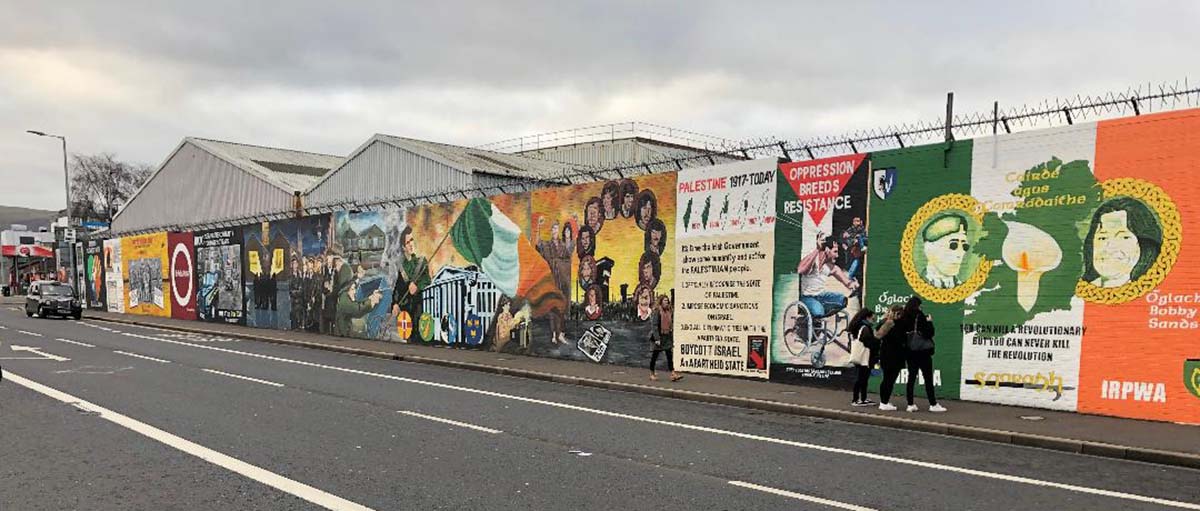
By Lee P. Ruddin
“He’s talkin’ sh*t!” mouths a short, skinny man thirty-odd yards away.
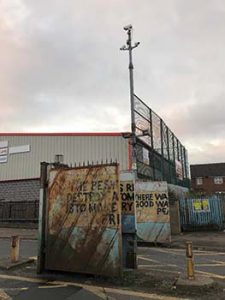 I’d noticed this bespectacled figure with a Peaky Blinders-like cap walking towards us when standing at the rear of our twenty-strong group at “Checkpoint Charlie” on Lanark Way in Belfast, Northern Ireland.
I’d noticed this bespectacled figure with a Peaky Blinders-like cap walking towards us when standing at the rear of our twenty-strong group at “Checkpoint Charlie” on Lanark Way in Belfast, Northern Ireland.
I feared this passer-by was going to be more vocal than the individual who interrupted a Jack the Ripper walk in London given this was the location where Republican guides handed over to their Loyalist counterparts between the (predominantly) Catholic Falls and Protestant Shankill Roads.
There’s been Black Taxi tours of the peace walls constructed during “The Troubles” (a thirty-year conflict that’s claimed over 3,500 lives notwithstanding it sounding like a Victorian euphemism for venereal disease) for years yet the unashamedly subjective nature of the Conflicting Stories tour by former combatants proved too tempting to miss.
Victims’ campaigners describe the advertising of the tours as ‘warped’, something I’d echo albeit to a lesser extent: specifically my paying £18 for a place when booking on The Belfast Free Walking Tour website.
My wallet-watcher misgivings were rapidly dispelled when meeting Robert, though, a stocky, beanie-wearing sexagenarian who was formerly a member of the Irish Republican Army (IRA) and who’s now a Sinn Féin activist after moving from the ‘trenches to the benches’. Whether it’s because it was an ice-cold day, I couldn’t say, but I was instantaneously drawn in by his warmth (something staff at the Titanic Hotel, who are as frosty as the iceberg that struck the vessel in 1912, could learn from) despite the fact my uncle served in the British Army and was stationed in what Robert calls the ‘occupied six counties’.
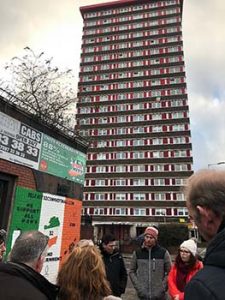 Starting at Divis Tower, he transported us back to August 1969 and the push for civil rights. Catholics were discriminated against by the Unionist-dominated administration (which was loyal to the British Crown and fearful of plots to join the twenty-six-county-Republic to the south) who presided over what was effectively a pogrom against the nationalist minority. Although Robert’s black-and-white photos are amateur compared with professional ones displayed in Titanic Belfast museum, the latter’s interactive galleries come a distant second to the interaction afforded with an ex-prisoner who was taught Irish by hunger-striker Bobby Sands.
Starting at Divis Tower, he transported us back to August 1969 and the push for civil rights. Catholics were discriminated against by the Unionist-dominated administration (which was loyal to the British Crown and fearful of plots to join the twenty-six-county-Republic to the south) who presided over what was effectively a pogrom against the nationalist minority. Although Robert’s black-and-white photos are amateur compared with professional ones displayed in Titanic Belfast museum, the latter’s interactive galleries come a distant second to the interaction afforded with an ex-prisoner who was taught Irish by hunger-striker Bobby Sands.
While imprisoned for planting bombs (1976-1988) Robert went on “blanket” and “no-wash” protests, protests he vividly describes as we huddle into our parka jackets and periodically tilt heads like curious dogs. The murders of his friend and grandfather proved sufficiently traumatising – indeed radicalising – that he joined the youth wing of the IRA before the organisation proper in 1974, aged seventeen.
As our multinational group (resembling a dream team of U.N. peace envoys with tourists from the Basque region, South Africa and Indonesia) continued to make its way westwards towards Falls Road, Scouse-sounding me is singled out when eyes are directed to the International Wall and a mural depicting Liverpudlian Joe Gleeson raising the Irish tricolour during the Easter Rising.
Robert doesn’t dwell on the past and 1916, surprisingly, but moves onto the “2023 Project” and the successes in extending opening hours of security gates. That Brexit (Britain leaving the E.U.) could jeopardise the E.U.-funded “Barriers and Mindsets” scheme leaves all demoralised however.
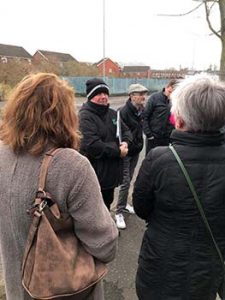 The spontaneous handshake between Robert and Noel soon lifts spirits (despite lifting thereof evidently the last thing on peoples’ minds on New Year’s Day) for here, in the present, are members respectively of Coiste and EPIC working side-by-side, literally hand-in-hand.
The spontaneous handshake between Robert and Noel soon lifts spirits (despite lifting thereof evidently the last thing on peoples’ minds on New Year’s Day) for here, in the present, are members respectively of Coiste and EPIC working side-by-side, literally hand-in-hand.
Back on Bombay Street, Robert said he’d taken tours on the ‘other’ side to better understand ‘their’ story, something which I desperately wished was happening today since – to quote Socrates, or was it Shania? – Noel didn’t ‘Impress Me Much’: while I’d not expected a guide as polished as, say, Terry at Crumlin Road Gaol, he appeared rusty in spite of tours being eighteen-months old.
A self-described former ‘sectarian bigot’ released under the terms of the Good Friday Agreement, Noel is candid if not charismatic: he’s the type of fella you wouldn’t need to pay a penny to for his thoughts; indeed he’s the sort, regardless of being an armed robber for the Ulster Volunteer Force (UVF), who’d give you his last.
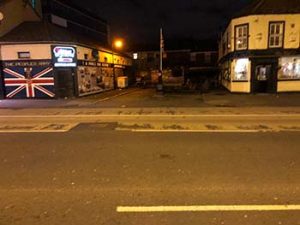 The history of Loyalism is little known compared with that of Republicanism, which is often romanticised, yet remains an important thread in the tapestry of the conflict – a thread told under fluttering Union flags and beside gable-wall murals honouring the dead of WWI. I’m ashamed to admit I thought Noel an ignoramus when referring to Bloody “Friday” – that occurred six months after the much-chronicled Bloody Sunday in 1972 – which claimed his friend’s life and proved a turning point in his. Ten others died after 26 bombs were detonated in 80 minutes.
The history of Loyalism is little known compared with that of Republicanism, which is often romanticised, yet remains an important thread in the tapestry of the conflict – a thread told under fluttering Union flags and beside gable-wall murals honouring the dead of WWI. I’m ashamed to admit I thought Noel an ignoramus when referring to Bloody “Friday” – that occurred six months after the much-chronicled Bloody Sunday in 1972 – which claimed his friend’s life and proved a turning point in his. Ten others died after 26 bombs were detonated in 80 minutes.
Walking westwards on Shankill Noel reminds us to ‘watch our backs’ (which had a different meaning ‘back in the day’, he jokes) as locals go about their business. With the lightened mood turning dark through the tragic details concerning the bombing of a fish shop in 1993, I thought the tour ought to be renamed Conflicting Emotions. Standing at Shankill Memorial Park I observed that there wasn’t the hushed reverence of the Garden of Remembrance on Falls, although this was arguably because many were simply concentrating on maintaining blood circulation by stamping their feet.
Shattered but still standing after a three-and-a-half-hour, five-kilometre walk I wet my whistle in the Europa, once the most bombed hotel in the world. Here I mulled over Noel’s concluding remarks that peace is a ‘desire’ for Loyalists/Unionists whereas it’s a ‘strategy’ for Republicans/Nationalists. If so, a “hard” border after Brexit may cause dissident Republicans to blow the dust off their guns thereby ensuring there’ll not only be KFC but possibly UVF, even RHC (Red Hand Commando), presence on the Shankill.
That said, HM Government’s £300m peace-building, post-Brexit pledge should guarantee (together, not insignificantly, with monies from tours) the soft-power work conducted by Robert and Noel – who persuade rather than pressurize (hard equivalent) youths to coexist peacefully – continues to prevent recrimination replacing reconciliation.
If You Go:
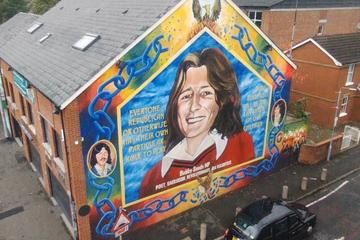
Belfast History Walking Tour The Ultimate Belfast experience
Three nights is more than enough to see the main sights in Belfast, although it’s a good base from which to visit Giant’s Causeway in the north and/or Dublin to the south (in the Republic). Fans of the epic HBO series Games of Thrones can join coach tours in either Belfast or Dublin.
Titanic Belfast, the world’s largest Titanic visitor experience, is a must-see on any tourist’s itinerary. While booking online doesn’t necessarily save you money, it enables you to jump the queue after selecting a specific time slot (earlier the better given crowds seriously depreciate the experience). English-speakers should also consider renting an audio guide.
Choose to stay in accommodation more centrally-located than the Titanic Hotel, which involves a 20-minute walk along the Lagan River (and over a bridge) to reach the centre of town. There’s a possibility of rain all year round throughout the British Isles, but for high probability of dry weather look to book between the months of May and September.
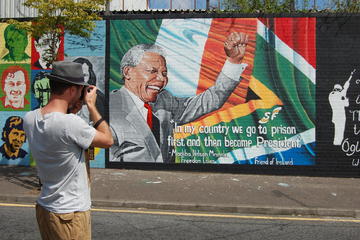
Belfast Mural Political Black Cab Tour
A frequent ‘Letter of the Month’ winner in UK travel newspapers/magazines, Lee P. Ruddin’s entry in Senior Travel Expert’s 2018 (Heritage) Writing Competition was shortlisted as Highly Commended by judges. His articles feature in Robert Fear’s Travel Stories and Highlights: 2019 Edition and at TravelMag. Born in Birkenhead on the Wirral in North West England, he currently resides in Birmingham, where he works in the security industry.
All photos by Lee P. Ruddin




Leave a Reply
You must be logged in to post a comment.